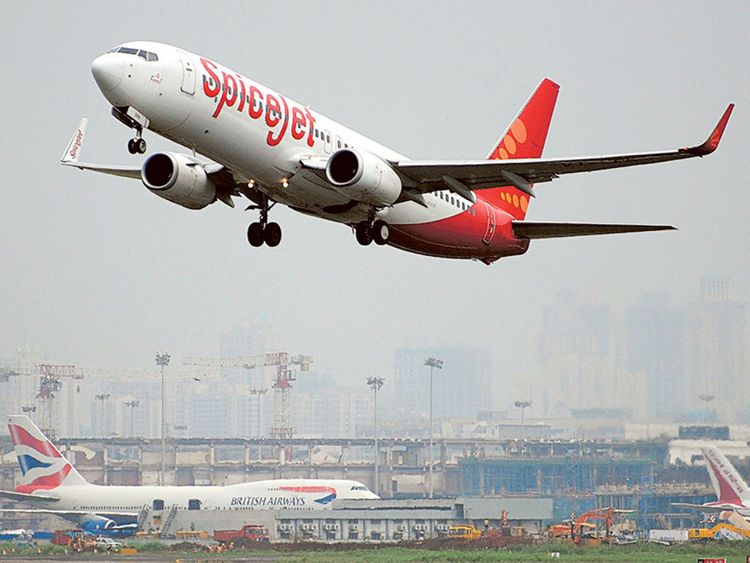SpiceJet has reported a net loss of INR 934.8 crore in FY2020; without forex impact under Ind‐AS 116, net loss would have been INR 237.8 crore.
India’s favourite airline and the biggest air cargo operator, reported a net loss of INR 807.1 crore in the fourth quarter of FY20 (that includes a non‐cash loss of INR 473.4 crore due to forex loss on restatement of lease liability due to Ind‐AS 116) against a profit of INR 56.3 crore in the same quarter of the previous year as business was adversely impacted due to the COVID‐19 pandemic and the nation‐wide lockdown that resulted in suspension of flight operations.
- Also Read – SpiceJet To Operate Flights On India-UK Routes
“Two key factors that adversely impacted our performance and the bottom line was the COVID‐19 pandemic that started affecting demand adversely from mid‐February and grounding of the 737 MAX, which has been out of service for over a year now. Despite the year long grounding of the MAX aircraft, SpiceJet ran a profitable operation till COVID hit demand from mid‐ February”, Said Ajay Singh, Chairman and Managing Director, SpiceJet.
Ajay Singh, Chairman and Managing Director, SpiceJet.
“Indian and the global aviation industry are going through the toughest‐ever phase in aviation history. We at SpiceJet have constantly adapted to the changing economic environment and I am happy that our cargo operations have performed very well. I am confident that things will only improve in the times to come. We remain cautious but optimistic about the future.” He added.
Ajay Singh, Chairman and Managing Director, SpiceJet.Advertisement
Read Air India’s divestment the sole option: Aviation Minister
Key Highlights For the Quarter ending March 2020:
- Capacity (in terms of seat kilometer) up by 23%
- Operating loss of INR 333.7 crore. Non‐cash Ind‐AS 116 impact of INR 473.4 crore. Net loss of INR 807.1 crore compared to a net profit of INR 56.3 crore in the same period last year.
- Operating revenues were at INR 2,863.9 crore for the reported quarter and INR 12,358.6 crore for fiscal 2020.
- Revenue from operations increased by 13%, in spite of weak demand due to COVID‐19.
- Revenue from cargo increased by 94%
- On an EBITDA basis, the loss was INR 223.6 crore for the reported quarter and profit of INR 1,273.9 crore for fiscal 2020. On an EBITDAR basis, the loss is INR 90.9 crore for the reported quarter and profit of INR 1,636.8 crore for fiscal 2020
- Registers the industry’s highest domestic load factor of 90%
Key Highlights For the Year ending March 2020:
- EBITDAR profit of INR 1,636.8 crore
- Reports a net loss of INR 934.8 crore in FY2020; without forex impact under Ind‐AS 116, net loss would have been INR 237.8 crore
- Passenger capacity up by 40%; a substantial increase in cargo capacity
- Operating income up by 36%
- Aircraft fleet at 114 as on March 31, 2020
- Registers domestic load factor of 92%; clocked 90% plus PLF for a record 58 successive months till February’20.
Other Key Points:
- Added 38 aircraft to the fleet.
- Operated 570 average daily passenger flights before COVID‐19.
- Inducted 100th aircraft, a Boeing 737, in May 2019
- Secured premium slots at key metros and international flying rights
- Consolidated airport operations in Mumbai at Terminal 2
- Added five 90‐seater Q400 aircraft taking Bombardier fleet size to 32
- Signed definitive codeshare agreement with Emirates
- Actively using Ras Al‐Khaimah airport as a hub for cargo operations
- Likely return to service of the MAX in the first quarter of CY2021 to be a big boost; will add operationally efficient aircraft to the fleet
Since April 1, 2019, the airline has added 38 aircraft which included 737s, Q400s, and freighters as it celebrated the big milestone of inducting its 100th aircraft – a Boeing 737.
During the lockdown, SpiceJet played a key role in keeping the country’s supply chain intact.
On April 7, 2020, SpiceJet operated India’s first cargo‐on‐seat flight carrying vital supplies in passenger cabin and belly space.
Since then, the airline has been regularly deploying its B737 and Q400 passenger aircraft to carry cargo in the passenger cabin.
Ind AS 116 “Leases” Effective April 1, 2019, the Group adopted Ind AS 116 “Leases”, applied to all lease contracts existing on April 1, 2019 using the modified retrospective method and has taken the cumulative adjustment to retained earnings, on the date of initial application {April l , 2019). As a consequence:
(A) On April 1, 2019 (transition date), the Group has recognised lease liability measured atthe present value of the remaining lease payments, and Right-of-Use {ROU) asset at its carrying amount net of any incentives (including sale-and-lease back gains) received as if the standard had been applied since the lease commencement date, and discounted using the lessee’s incremental borrowing rate as at April 1, 2019. On account of adoption of lnd AS 116, as at April 1, 2019, the retained earnings have been reduced by Rs 3,023.63 million.
(B) In the statement of profit and loss, the nature of expenses in respect of leases has changed from lease rent in the earlier periods to depreciation cost on the ROU asset and finance cost on lease liability as per Ind AS 116 on the Group’s financial results for the quarter and year ended March 31, 2020, is as follows:

For more details, please log in to SpiceJet’s official website.
Wear Mask. Follow Social Distancing. Stay Safe.
(With Inputs – The Finance Post)
For the latest travel news and updates, Follow and connect with us on Facebook, Twitter and Linkedin!
Also Read – Turkey To Resume International Flights To India From August 1





